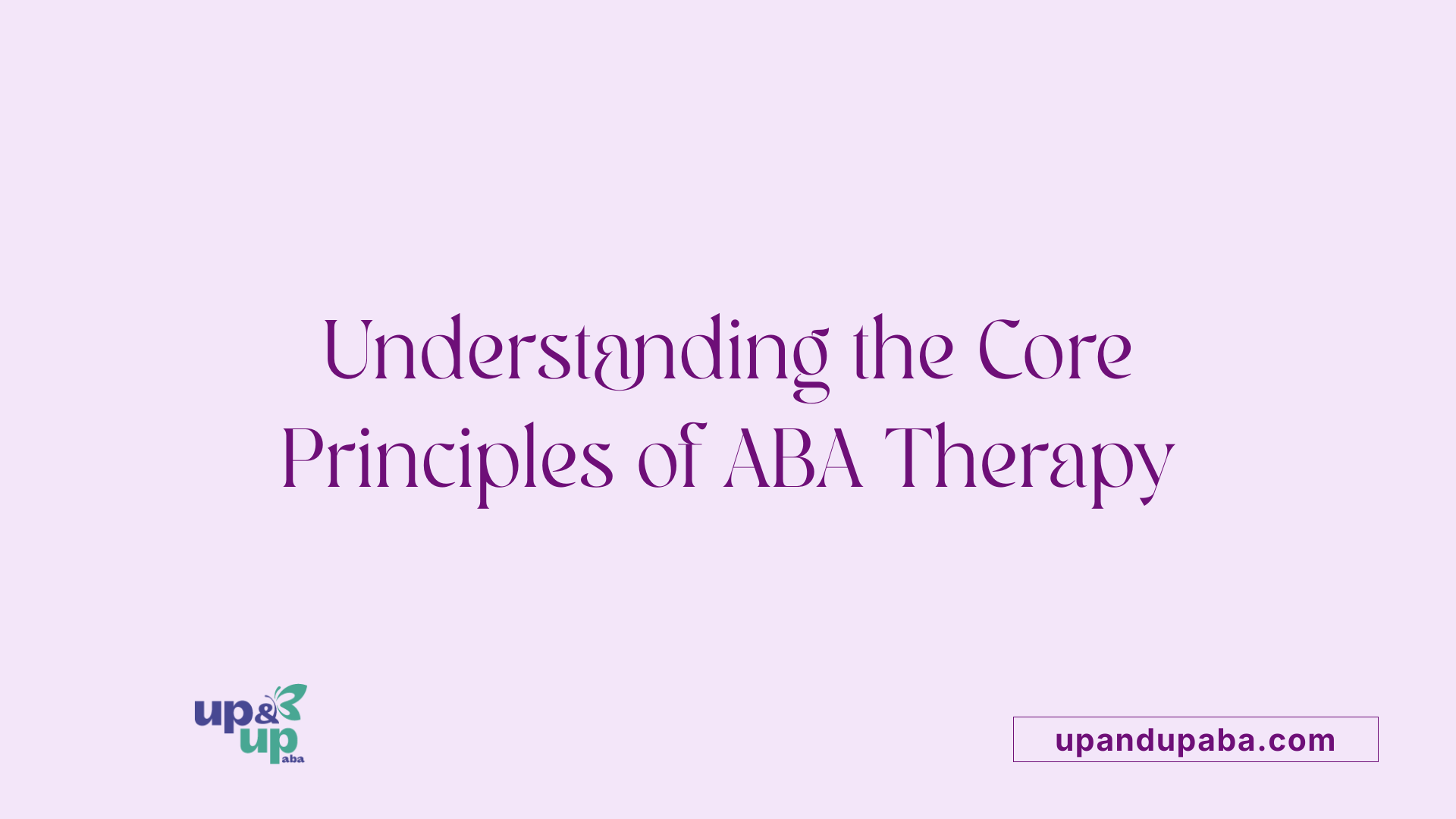ABA Therapy and Autism Spectrum
Understanding the Role of ABA Therapy in Autism

Introduction to ABA Therapy
Applied Behavior Analysis (ABA) therapy has been a cornerstone in autism treatment for decades, widely recognized for its structured approach to enhancing social, communication, and learning skills. With autism affecting a significant number of children, the need for evidence-based interventions like ABA is critical. This narrative delves into the principles, methodologies, benefits, and challenges of ABA therapy, offering a comprehensive overview for parents, educators, and caretakers seeking effective autism interventions.
Foundation of ABA Therapy

What is ABA therapy for autism?
Applied Behavior Analysis (ABA) is a research-based therapeutic approach designed to enhance social, communication, and learning skills in individuals with autism. It focuses on increasing positive behaviors and decreasing harmful ones through systematic reinforcement and individualized treatment plans created by qualified behavior analysts. The flexibility of ABA allows it to be tailored to the unique requirements of each individual, addressing various learning and behavioral challenges.
ABA employs a range of techniques to facilitate learning, including Discrete Trial Training (DTT), which simplifies tasks into smaller components for easy understanding, and Pivotal Response Treatment (PRT), which encourages natural learning through play and interaction. This method has been validated through numerous studies, highlighting how early interventions positively impact cognitive and social skills, particularly when introduced between the ages of 2 and 6.
History and principles of ABA
Originally developed in the 1960s, ABA is grounded in behavioral science, emphasizing that behavior is influenced by environmental factors. The approach is based on a foundational methodology that involves understanding the "A-B-Cs" (antecedent-behavior-consequence) to analyze and modify behaviors effectively. By systematically altering the antecedents and consequences, therapists can create better learning and social interaction opportunities for individuals with autism. This evidence-based approach has been recognized by major health organizations as a robust treatment option, showing significant improvements in functional skills and overall quality of life for those affected.
Effectiveness of ABA Therapy

How effective is ABA therapy for autism?
ABA therapy, or Applied Behavior Analysis therapy, has been demonstrated to be highly effective for children with autism spectrum disorder (ASD). Recent studies highlight an impressive over 89% success rate in enhancing essential areas such as social, communication, and behavior skills. Furthermore, meta-analytic reviews reinforce its effectiveness with notable improvements in IQ, communication capabilities, and language skills.
Recognized as one of the most effective evidence-based interventions for ASD, ABA therapy is unique in its approach by breaking down complex skills into manageable steps. This structured methodology facilitates a clearer learning pathway for children. Many find themselves engaged in ABA programs for extended periods, with approximately 66% of children remaining in therapy for at least 12 months. However, this percentage decreases to less than 50% for those who continue with therapy after 24 months.
Additionally, ABA therapy significantly contributes to improved adaptive behavior, providing individuals with fundamental skills necessary for daily living and promoting greater independence. These outcomes demonstrate the transformative potential of ABA in the lives of children with autism, enhancing their overall quality of life and functional independence.
Practical Application in Autism Support

Impact on Different Age Groups
Applied Behavior Analysis (ABA) is effective for individuals across a broad age spectrum—from toddlers to adults. Using personalized strategies, ABA helps young children, especially those diagnosed with Autism Spectrum Disorder (ASD), as early as age two. Intensive early interventions, such as Early Intensive Behavioral Intervention (EIBI), can lead to significant gains in language and social skills.
For older children, ABA focuses on refining essential skills needed for academic success and fostering social interactions. Applications extend into adolescence and adulthood, where ABA principles can assist in building independence and coping strategies in daily life. Each age group receives targeted interventions tailored to their developmental stage.
Day-to-Day Integration of ABA
ABA therapy is designed for seamless incorporation into everyday activities. Programs are adaptable, allowing practice of skills in various environments—home, school, and community. For instance, practices like the token economy can motivate positive behavior in classroom settings, helping to foster a positive learning environment.
Parents are often encouraged to engage in ABA techniques, reinforcing lessons and ensuring consistency between therapy sessions and daily routines. This holistic approach enhances the likelihood of successful behavioral changes and skill acquisition, enabling individuals with ASD to navigate daily challenges and thrive within their communities.
Does ABA therapy help with autism?
ABA therapy, or Applied Behavior Analysis, is a widely recognized and evidence-based intervention designed to help individuals with autism develop essential skills and decrease harmful behaviors. It focuses on individualized goals, improving communication, social skills, and self-care while using methods like positive reinforcement to promote desired behaviors. ABA has shown effectiveness across various age groups and can enhance academic performance, attention, and overall quality of life. The therapy approach includes ongoing assessment and data collection to tailor interventions based on each individual's unique needs and progress. Many who have undergone ABA therapy report significant improvements in their skills and coping mechanisms, making it a valuable option for those on the autism spectrum.
Methodologies in ABA Therapy

What are the methodologies and techniques used in ABA therapy?
ABA therapy utilizes a diverse array of methodologies designed to foster positive behavioral changes in children, especially those diagnosed with Autism Spectrum Disorder (ASD). One cornerstone of this approach is positive reinforcement, where desired behaviors are rewarded immediately, thus increasing their likelihood of repetition.
Discrete Trial Training (DTT) is another significant technique. This method involves breaking down skills into smaller, manageable components, allowing for focused, step-by-step instruction. Additionally, Functional Behavior Assessments (FBA) help identify specific challenging behaviors to target for improvement.
Pivotal Response Training (PRT) emphasizes pivotal behaviors, which have a wide impact on a child's learning and social skills, promoting comprehensive development.
Modeling and video modeling are techniques employed to demonstrate desirable behaviors for children to imitate, making learning more relatable. The Picture Exchange Communication System (PECS) is particularly beneficial for nonverbal children, facilitating communication through visual symbols. From these diverse methodologies, ABA is designed to be individually tailored, involving family for contextual learning and applying skills in real-life scenarios.
How does ABA customize treatment and track progress?
Customization is a hallmark of ABA therapy, ensuring treatments are specifically tailored to meet the unique needs of each child. This is achieved through comprehensive initial assessments conducted by Board Certified Behavior Analysts (BCBAs), who formulate personalized treatment plans with clear goals aligned with each child’s capabilities and challenges.
Tracking progress is crucial in ABA. Continuous data collection is employed to monitor behavioral changes and improvements. Regular evaluations help adjust strategies based on individual development, making sure that interventions remain relevant and effective. This iterative approach guarantees that children not only advance in their skills but also helps maintain consistency in their learning environments.
ABA as a Gold Standard in Autism Treatment
Is ABA therapy considered the gold standard for autism treatment?
Yes, ABA therapy is widely recognized as the gold standard for autism treatment, endorsed by authoritative bodies such as the U.S. Surgeon General and the American Psychological Association. Its framework is grounded in extensive scientific research, which supports its effectiveness in teaching crucial skills including communication, social interactions, and daily living capabilities. A key aspect of ABA is its focus on reducing challenging behaviors by investigating their root causes rather than merely addressing the symptoms.
What are the various ABA models for different stages?
ABA offers various models tailored to suit different developmental stages and individual needs. Here are a few notable models:
| ABA Model | Target Age Range | Focus |
|---|---|---|
| Early Intensive Behavioral Intervention (EIBI) | Under 5 years | Comprehensive skill development at an intensive level, focusing on language and social skills. |
| Early Start Denver Model (ESDM) | 12 to 48 months | Play-based, emphasizing emotional, cognitive, and language development with family involvement. |
| Pivotal Response Treatment (PRT) | 2 to 9 years | Child-initiated, enhancing pivotal behaviors such as motivation and social skills. |
These models emphasize the importance of personalizing therapy to suit each child’s specific requirements, ensuring a holistic approach that supports learning in diverse environments. Parental engagement is vital throughout this process, reinforcing the strategies learned during therapy.
Benefits and Challenges of ABA
What are the benefits and drawbacks of ABA therapy?
Applied Behavior Analysis (ABA) therapy offers numerous advantages for children with autism. Notably, it helps improve communication and social skills, fostering better interaction with peers and family. The individualized treatment plans developed for each child ensure that their unique needs are met, focusing on essential life skills that enhance independence.
Research backs the effectiveness of ABA therapy, with evidence from major health organizations supporting its practices. Involve parents in the learning process is a key benefit, allowing families to reinforce desired behaviors at home, which further solidifies the skills learned during therapy.
However, there are drawbacks to consider. Critics argue that ABA therapy can sometimes appear overly repetitive and rigid, raising concerns about whether it respects the individuality of children. The intensity of sessions, which may range from 10 to 40 hours a week, can be overwhelming for both children and their families. Moreover, the financial burden for intensive therapy can be significant, limiting access.
There's an ongoing debate about the impact ABA may have on natural behaviors. Although modern practices focus on positive reinforcement instead of punishment, questions remain regarding how the therapy influences a child's personality. As discussions around ABA continue, it remains essential to address both its benefits and challenges to ensure it meets the best interests of the child and family.
Navigating Ethical Considerations

What are the ethical considerations surrounding ABA therapy?
Ethical considerations surrounding ABA therapy encompass a significant range of issues, particularly regarding its approach and impact on autistic individuals. While ABA is recognized for its effectiveness in teaching skills and managing behaviors, historical practices, such as the use of punishment, raise concerns about its ethical validity.
Critics argue that ABA can prioritize conformity to neurotypical standards, potentially overshadowing the individuality of autistic persons. This focus might lead to emotional harm or even negative psychological outcomes, such as PTSD or identity confusion, especially if the therapy emphasizes eliminating behaviors without fostering the development of new skills.
Moreover, the intensity of therapy—often requiring 20 to 40 hours a week—can be overwhelming for some children. Ethical practice in modern ABA emphasizes positive reinforcement and the development of individualized treatment plans. This shift highlights the need for a balanced approach that respects the dignity and autonomy of the individuals receiving therapy.
Conclusion and Future Directions
Understanding the multifaceted nature of ABA therapy is crucial for caregivers and professionals seeking effective treatments for autism. While ABA remains a leading intervention due to its positive outcomes and strong endorsements, it's vital to continue refining practices to ensure ethical and individualized care. As research progresses, ongoing adjustments to methodologies and increased awareness of ethical considerations promise to enhance its application, thus maximizing benefits for individuals with autism. This commitment to continuous improvement ensures ABA therapy adapts to the diverse needs of those it serves, promoting independence and a better quality of life for people on the autism spectrum.
References
- Applied Behavior Analysis (ABA) | Autism Speaks
- Applied Behavior Analysis in Children and Youth with Autism ...
- The Controversy Around ABA - Child Mind Institute
- Applied Behavior Analysis (ABA) - Cleveland Clinic
- Behavioral Treatment of Autism and Other Developmental ... - BACB
- ABA Psychology and Autism | National University
- Autism Spectrum Therapies | ABA Therapy Services
- Questions and answers about ABA | Autism Speaks



